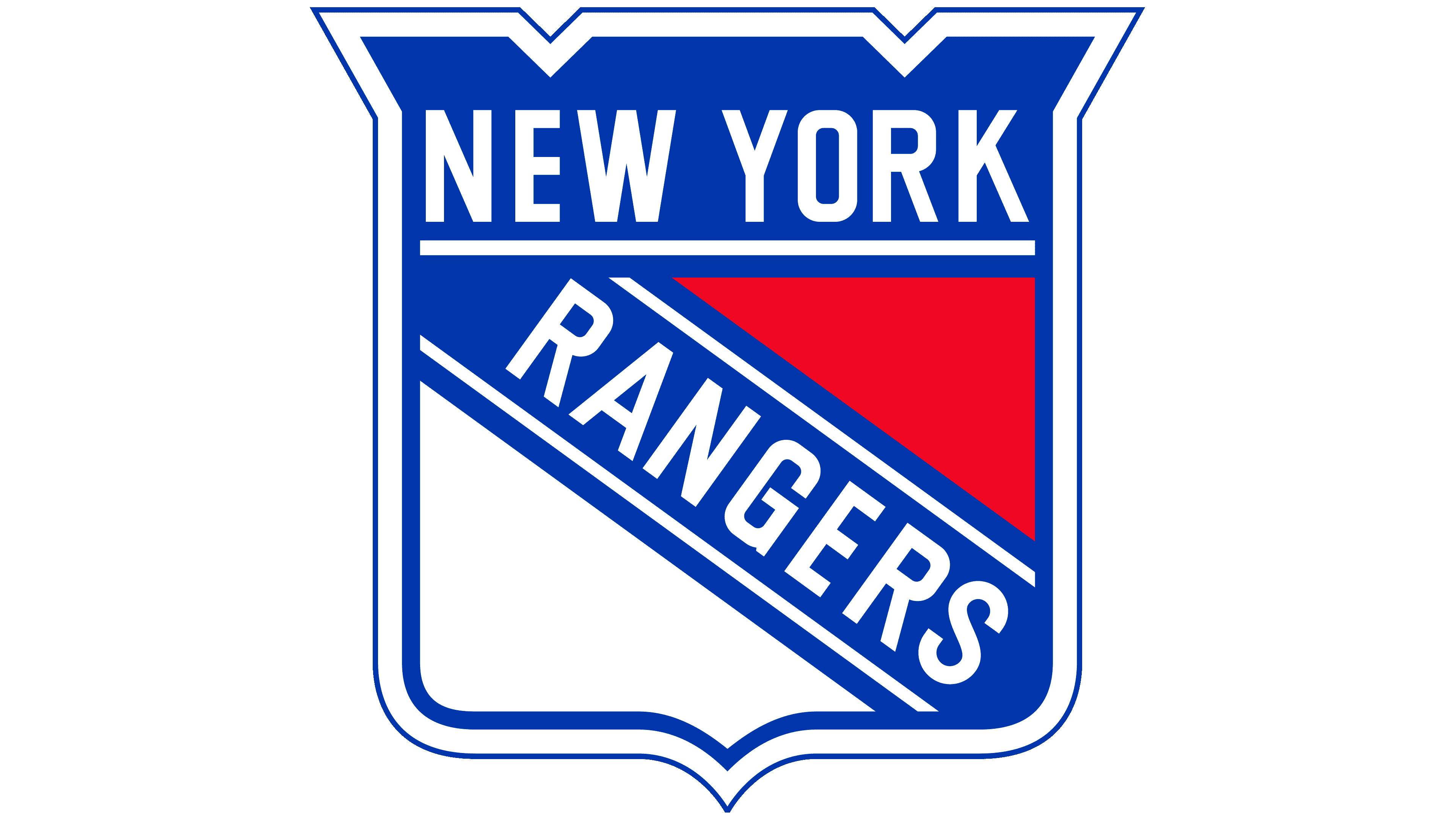New York Rangers Logo
The New York Rangers, an illustrious NHL franchise, were established in 1926. Known for their distinctive red, white, and blue uniforms, they’re a part of the Original Six, signifying the oldest, most celebrated teams in the league. They play their home games at the iconic Madison Square Garden in New York City. The Rangers have clinched the Stanley Cup multiple times, engraving their legacy in the hockey world. Owned by Madison Square Garden Sports Corp., they continue to enthral fans with their dynamic and riveting play.
Meaning and history
Initially, ownership was under the Madison Square Garden Corporation, which later subdivided, resulting in the inception of Madison Square Garden Sports Corp., the contemporary owner of the Rangers.
The Rangers, holders of multiple Stanley Cup victories, have been shaped by diverse coaching philosophies, witnessing substantial shifts in gameplay and strategy over the decades. The team’s essence, deeply ingrained in tradition and innovation, has persevered amidst managerial and player changes.
Throughout their journey, the Rangers have maintained their iconic emblem and uniforms, intertwining their recognizable aesthetic with modern elements, reflecting the dynamic nature of their evolving identity in the world of hockey.
1927 – 1935
The inaugural proprietor of the club was George Lewis Rickard, renowned as a pugilism promoter and the commanding officer of Madison Square Garden. The craftsman conceptualized the emblem for the New York Rangers to bear resemblance to their adversaries, the New York Americans, intentionally crafting a harmonizing visual identity. The logo was constructed with a shield contour and adorned with a palette of red, blue, and white hues.
Atop the shield, the “New York” insignia was situated over a horizontal band of blue. Concurrently, the denomination “Rangers” was manifested on a slanted band, revealing the team’s identity. The emblem harbored a crimson vertex at the upper left segment and a white domain on the inferior right quadrant.
The juxtaposition of colors and the strategic placement of elements within the logo were meticulously orchestrated to project a harmonious yet distinctive representation of the club’s ethos and heritage. The subtle nuances in the design elements encapsulated the spirited rivalry and the vibrant sports culture of New York, whilst maintaining a unique semblance to mark the Rangers’ distinct identity in the sporting realm. The convergence of traditional and dynamic design elements underscored the team’s foundational values and their enduring presence in the competitive landscape of hockey.
1936 – 1947
In 1936, a transformation was implemented in the club’s visual identity, refining the red and blue hues to render them more sophisticated and deeper. The inscription “Rangers” underwent a color alteration, adopting a red font, diverging from the original white. The emblem received an additional embellishment, incorporating an exterior border in white. Apart from these modifications, this symbol bore a striking resemblance to their inaugural emblem.
This renewed aesthetic not only underscored the team’s evolving identity but also highlighted a meticulous attention to detail and a commitment to maintaining the heritage and essence of the original design. The subtle enhancements in the color palette and the refined detailing served to reinforce the team’s distinguished presence and enduring legacy in the world of sports. The nuances in the design reflected a harmonious blend of tradition and innovation, creating a timeless visual representation of the Rangers’ spirit and values. The emblem, with its nuanced alterations, continued to be a proud insignia, symbolizing the relentless pursuit of excellence and the unwavering passion that defines the team.
1947 – 1952
The 1947 revamp was notably more substantial. The alterations weren’t limited to the tints but extended to the very form of the shield, which now embraced a rectangular architecture. The emblem representing the New York Rangers was further refined with the inclusion of a peripheral blue boundary.
This reimagining of the logo presented a striking and modern visual identity, aligning with the evolving spirit of the team. The shift from the traditional shield to a more angular structure symbolized a blend of innovation and steadfastness, reflecting the team’s progressive outlook. The blue outline served to accentuate the emblem, adding an element of vibrancy and distinction to its appearance. This transformative design approach highlighted the team’s commitment to evolution and excellence, aiming to strike a balance between respecting heritage and embracing change. The refined aesthetics of the logo stood as a testament to the Rangers’ continuous pursuit of elevated representation in the evolving landscape of the sport. The added detailing and reshaped structure represented a forward-thinking perspective, aiming to resonate with the dynamic and enduring spirit of the Rangers.
1953 – 1967
In 1953, the emblem of the New York Rangers evolved further towards a more pronounced rectangular form. Unlike its predecessor, the rectangle was aligned horizontally. The external blue border underwent modification to appear slimmer yet more pronounced. However, these transformations didn’t bring about any major shifts in the overall design aesthetic.
This subtle enhancement in the logo’s structure represented a refined visualization of the team’s identity, focusing on simplicity and clarity. The restrained adjustments in the alignment and the border detailing conveyed a sense of minimalistic sophistication, maintaining the essence of the original design. The nuanced modifications aimed to modernize the emblem subtly, reflecting a harmonious blend of tradition and contemporary elegance. The emblem, though visually closer to a modern rectangle and featuring a refined border, retained its foundational elements, preserving the iconic identity of the New York Rangers. The understated changes were a nod to the evolving dynamics of visual representation in the sporting domain, underlining a seamless integration of historical legacy and modern design principles.
1968 – 1970
Between 1968 and 1970, modifications made to the logo were relatively subtle and primarily focused on font and spacing adjustments. The inscriptions within the logo adopted a more refined and slender typography, and the white spacing surrounding the outer border experienced a diminution. Consequently, the overall shield projection appeared somewhat more compact.
However, these were the sole divergences from the original design. The inscription, “New York Rangers,” maintained its original color of white and was positioned consistently with the preceding designs. The emblem continued to echo the timeless and iconic visual identity of the team, with its concise modifications reflecting a thoughtful balance between preservation of tradition and aesthetic refinement. The minor alterations during this period were indicative of a nuanced approach to brand identity, subtly embracing change while upholding the foundational elements that have been synonymous with the team’s image. The restrained adjustments were aimed at enhancing visual coherence and modernizing the logo in alignment with evolving design sensibilities.
1971 – 1977
In 1971, the emblem representing the New York Rangers underwent another modification. During this update, the lettering height for the words “New York” and “Rangers” experienced a reduction, making the font appear more compact. The existing color palette was retained, ensuring consistency with the previous versions of the logo. Additionally, alterations were made to the red triangle’s boundary, transitioning it to white lines.
This rendition of the logo exemplified a nuanced refinement, subtly revamping the text dimensions while preserving the inherent vibrancy and dynamism of the color scheme. The visual continuity of the emblem was maintained, echoing the enduring spirit and rich heritage of the team. These meticulous adjustments highlighted the organization’s attention to detail and commitment to maintaining a balance between tradition and modernity. The emblem, with its revamped features, continued to serve as a symbol of the team’s steadfast identity and its enduring legacy in the sporting world.
1978 – 1998
For three decades, the emblem of the Rangers remained steadfast, witnessing no substantial modifications. The tweaks introduced in 1978 were relatively minor, reflecting a meticulous approach to design transformation. The color palette experienced a transition, adopting more luminous shades of red and a mellower blue. Both the shield and the wordmarks were preserved in their original forms, sustaining the iconic and recognizable elements of the logo.
This period marked a time of visual consistency for the Rangers, emphasizing the importance of maintaining a stable and enduring identity. The subtlety in alterations underscored a commitment to heritage while subtly refreshing the aesthetic appeal. It continued to represent the team’s enduring legacy and commitment to excellence, serving as a timeless symbol in the ever-evolving world of sports, connecting past traditions with present aspirations and future endeavors. The delicate balance between change and continuity highlighted the organization’s reverence for its history and its subtle adaptation to the changing times.
1999 – Today
In 1999, the emblem of the New York Rangers underwent a subtle refurbishment. It adopted a form that more closely resembles an extensive rectangle, incorporating elements reminiscent of medieval fortification walls. Visible on this ‘battlement’ are featured recesses, referred to architecturally as “dovetails.” This component accentuates the team’s linkage with historical elements, showcasing its venerability and unassailability to adversaries.
The principal segment of the emblem is segmented diagonally into three areas. The top features a red triangle, the center houses the word “Rangers,” and the bottom contains a white element, akin to a triangle in form. Above these, the phrase “New York” is articulated, separated by a white line. Encircling the symbol’s perimeter are two bands – a broad white one and a slender blue one, adding to the emblem’s visual depth and character.
This iteration not only continues to reflect the team’s rich heritage and enduring essence but also introduces a nuanced architectural flavor, offering a harmonious blend of tradition and sophistication. It subtly conveys the resilience and timeless valor of the team, symbolizing a fortress that stands impervious to challenges, a silent guardian of the team’s illustrious legacy and enduring spirit.



















